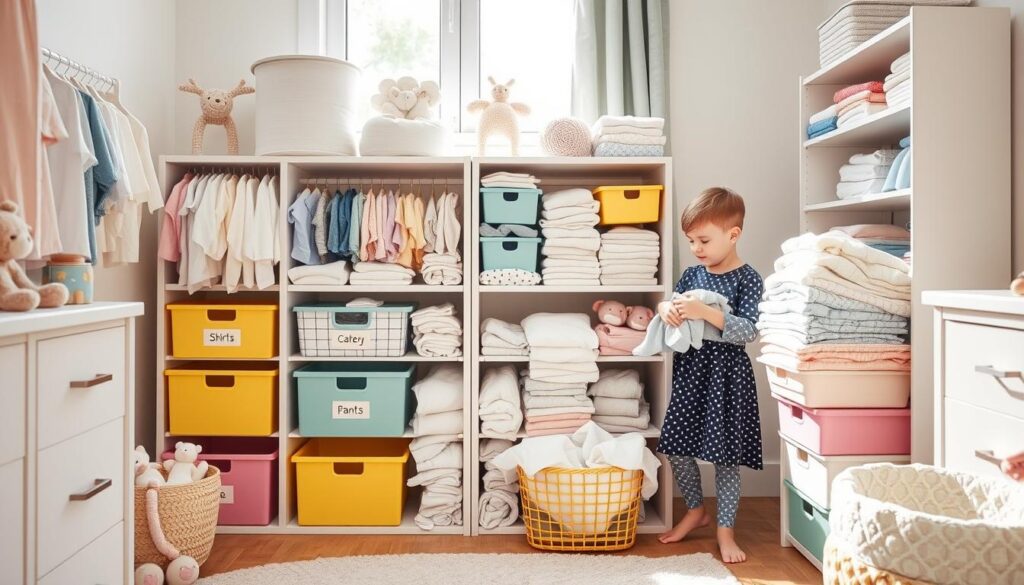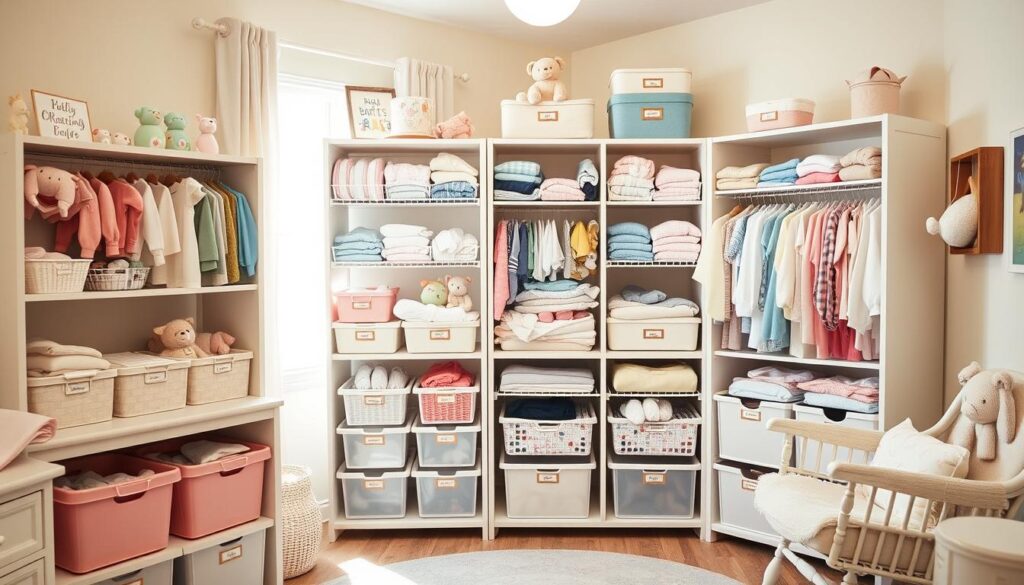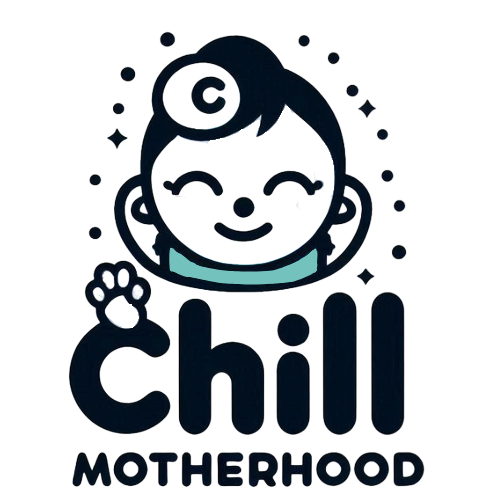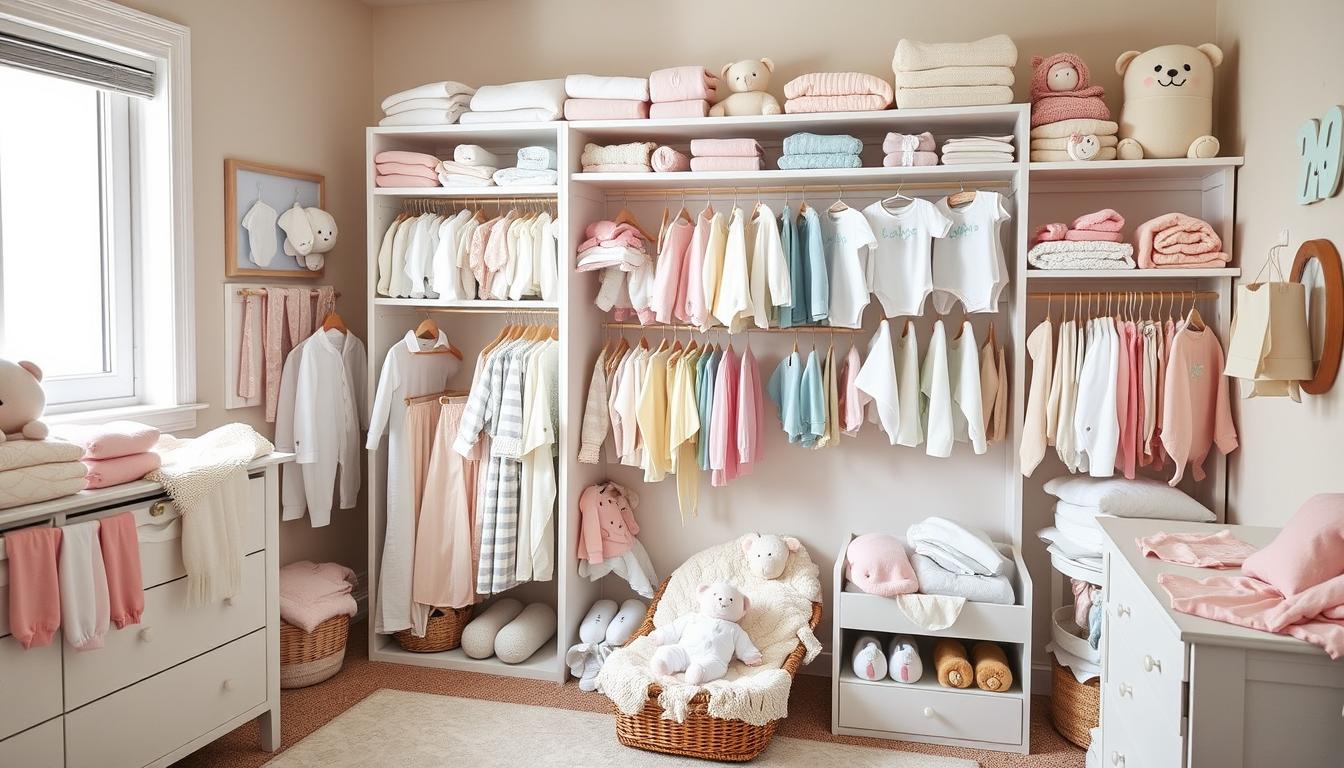Keeping your little one’s wardrobe organized can be tough. But, with the right strategies, it’s easier. This guide will help you sort, declutter, and find smart storage solutions for your baby’s clothes.
Organizing your baby’s clothes makes your home neat and helps you find outfits quickly. Simple techniques can keep your baby’s clothes ready to go. This saves time and reduces morning stress.
Contents
- 1 Assessing Your Baby’s Wardrobe
- 2 Decluttering Unwanted Clothing
- 3 Choosing the Right Storage Solutions
- 4 Labeling for Easy Access
- 5 Seasonal Rotation of Clothing
- 6 Organizing Baby Clothes by Function
- 7 Creating a Baby Clothing Inventory
- 8 Involving Older Siblings
- 9 Establishing a Routine
- 10 Maintaining an Organized Space
- 11 Easy Access for Caregivers
- 12 Time-Saving Tips for Busy Parents
- 13 FAQ
- 13.1 How do I determine the right size and growth stage for my baby’s clothes?
- 13.2 How should I sort baby clothes by season?
- 13.3 What should I do with baby clothes that my child has outgrown or no longer wears?
- 13.4 What are the pros and cons of using bins and baskets to store baby clothes?
- 13.5 How can I effectively label my baby’s clothes for easy access?
- 13.6 When should I swap out my baby’s seasonal clothing?
- 13.7 How do I organize baby clothes by function?
- 13.8 What are the benefits of maintaining a baby clothing inventory?
- 13.9 How can I involve my older children in organizing baby clothes?
- 13.10 What daily habits and routines can help me maintain an organized baby clothing space?
- 13.11 How can I make my baby’s clothes easily accessible for caregivers?
- 13.12 What time-saving tips can I use to keep my baby’s clothes organized?
Key Takeaways
- Assess your baby’s wardrobe to determine size and growth stage, sort by season, and identify frequently worn items.
- Declutter unwanted clothing through donation, recycling, or upcycling options.
- Choose the right storage solutions, such as bins, baskets, and shelving, to maximize your space.
- Label clothing items for easy access and implement a seasonal rotation system.
- Organize clothes by function, such as everyday outfits and special occasion wear.
Assessing Your Baby’s Wardrobe
Organizing your baby’s wardrobe can feel overwhelming. But, with the right steps, you can make it easier. Start by looking at what your baby already has.
Determine Size and Growth Stage
Sort through your baby’s clothes and check the sizes. Look at the size labels to see how your child is growing. This helps you know what fits and what needs to be replaced.
Sort Clothes by Season
Then, sort clothes by season. This makes it easier to find what your baby needs. It also helps you see what’s missing in your storing infant apparel or arranging newborn outfits. Group items like onesies, shirts, pants, and coats by season.
Identify Frequently Worn Items
- See which clothes your baby likes best, like a favorite onesie or cozy pajamas.
- Make sure these items are easy to find and have enough on hand. This makes dressing your baby simple.
- Keep a few extra of these items ready to avoid doing laundry too often.
By carefully checking your baby’s wardrobe, you can make better choices. This helps with storing infant apparel and arranging newborn outfits. It saves you time and stress, leading to a more organized wardrobe.
Decluttering Unwanted Clothing
As your little one grows, their wardrobe can quickly become overwhelming. Decluttering unwanted baby clothes is key to keeping a tidy nursery. By sorting and donating or recycling, you can have a wardrobe that fits your child’s needs.
Donation Options for Baby Clothes
Donating gently used baby clothes is a great way to help others. Look for local charities, shelters, or community groups that accept baby clothes. These donations can help families in need and give your child’s old clothes a new home.
Recycling and Upcycling Ideas
- Turn old baby clothes into quilts, pillows, or DIY projects to give them new life.
- Use small fabric scraps for cleaning rags or craft supplies.
- Check out textile recycling programs for responsible disposal of worn-out clothes.
What Not to Keep
When decluttering, choose only items that are in good shape and fit your child. Discard or recycle clothes that are stained, torn, or too worn. Also, let go of clothes that don’t match your child’s style or preferences.
“The less you have, the more you can appreciate and enjoy it.”
By managing your nursery wardrobe well, you can have a tidy and efficient system. This makes it easier to keep your child’s clothes organized and functional.

Choosing the Right Storage Solutions
Finding the right storage for your baby’s clothes is key. You have many choices, from bins and baskets to shelving systems. Let’s look at how to pick the best storage for your baby’s closet and use your space well.
Bins and Baskets: Pros and Cons
Bins and baskets are great for organizing baby clothes. They come in many sizes, materials, and styles. They’re easy to access and look good, helping you sort clothes by type or size.
But, there are downsides. They might not show what’s inside, and you need to keep them clean.
Shelving Ideas for Baby Clothes
Shelving systems can change how you organize your baby’s closet. You can choose from wall-mounted or free-standing shelves. These give lots of space to arrange and show off your baby’s clothes.
Look for shelves that can grow with your child. Adding labels or bins helps keep things organized.
Utilizing Closet Space Effectively
Use your nursery’s closet space wisely. Install hanging rods at different heights for clothes by size. Use vertical space with shelves or cubbies.
Get organizers like dividers, baskets, or clear bins. They help keep things visible and easy to find. Check your storage needs often and adjust as your baby’s clothes change.
Try different storage options and tailor your nursery’s closet. This way, you can manage your baby’s clothes efficiently. With the right infant clothing storage solutions and sorting baby’s closet tips, you’ll keep their wardrobe tidy and easy to reach.
Labeling for Easy Access
Organizing your baby’s wardrobe is more than just decluttering and finding storage. Labeling clothes is key to a tidy closet and managing outfits. Creative labels can turn a messy closet into a place where you can find what you need fast.
Creative Labeling Ideas
There are many ways to label baby clothes. You can use color-coding or personalized tags. Clear bins or baskets with labeled dividers are great for sorting clothes. Or, try hanging organizers with customizable labels.
- Attach cute, themed labels to storage containers, such as images of animals or characters your baby loves.
- Use chalkboard labels or dry-erase markers to easily update sizes and seasons as your little one grows.
- Create a digital inventory with photos and descriptions of each item, accessible on your smartphone or tablet.
Benefits of Clear Labeling
Efficient managing of baby’s clothes and streamlining your baby’s wardrobe are big pluses of clear labeling. It makes finding the right outfit quick and easy. Plus, it keeps your closet tidy and makes it simple to switch out seasonal clothes.
Digital Labeling Options
Today, apps and tools help you manage your baby’s clothes. You can scan barcodes or upload photos. These tools make tracking your baby’s clothes easy. They help you keep your wardrobe organized and accessible with just a few taps.
Seasonal Rotation of Clothing
Organizing your baby’s wardrobe can feel endless. But, learning to rotate clothes seasonally can simplify things. Knowing when to switch clothes and how to store the rest can save space and keep your baby’s closet neat.
When to Swap Out Clothes
As your baby grows, so do their clothing needs. It’s key to keep up with these changes for the right weather. Here’s when to swap clothes:
- Switch to lighter, breathable fabrics as the weather warms up in spring.
- Transition to heavier, insulating clothing as the temperatures drop in fall.
- Be mindful of growth spurts and adjust the sizing of clothes accordingly.
Best Practices for Seasonal Storage
When storing off-season clothes, follow these tips to keep them in great shape:
- Clean and inspect all items before packing them away.
- Invest in airtight containers or storage bins to protect against dust and moisture.
- Label the containers clearly with the contents and the season they’re intended for.
- Store the containers in a cool, dry place to prevent fading or damage.
Maximizing Space
With a growing baby, space for storage is crucial. Here are ways to use your space wisely:
- Fold clothes neatly and stack them vertically in drawers or bins.
- Utilize vertical space with shelving or hanging organizers.
- Rotate seasonal items to free up space in the active wardrobe.
By mastering seasonal clothing rotation and smart storage, you can keep your baby’s closet tidy. This makes it easier to organize baby clothes and store infant apparel all year.
Organizing Baby Clothes by Function
As your baby’s wardrobe grows, it’s key to organize clothes by function. This makes your daily routine smoother. It saves time and reduces stress by separating everyday and special occasion clothes.
Everyday Outfits vs. Special Occasion Clothes
Set aside a spot for your baby’s everyday clothes, like onesies and t-shirts. These are what you use most. Keep special occasion outfits, like holiday dresses, in a separate area.
Grouping by Clothing Type
- Sort clothes by type, like tops, bottoms, and sleepwear.
- Fold and store similar items together for easy access.
- Use clear bins or baskets with labels to keep things organized.
Accessories: Storage Solutions
Remember baby accessories like socks and hats. Give them their own spot to avoid losing them. Use dividers or trays to keep them tidy and easy to find.

Organizing your baby’s clothes by function makes dressing them a snap. It’s perfect for both special occasions and everyday wear.
Creating a Baby Clothing Inventory
Managing a baby’s wardrobe can be tough. A good way to handle it is by making a detailed inventory of their clothes. This tool can change how you organize your baby’s clothes.
Benefits of Keeping an Inventory
Keeping track of your baby’s clothes has many benefits. It lets you know what you have, their sizes, and when they need to be replaced. This way, you can buy only what’s needed and avoid clutter.
Easy Ways to Track Baby Clothes
- Create a spreadsheet or use a note-taking app to list all your baby’s clothing items, including size, season, and quantity.
- Take photos of each clothing item and organize them digitally for quick reference.
- Use physical storage containers or bins and label them clearly with the contents.
Using Apps for Inventory Management
Today, many apps help manage your baby’s clothes. Apps like Cleo, Sortly, and Baby Wardrobe make it easy to log and track your baby’s clothes. These apps can make organizing your baby’s clothes simple.
“Having a baby clothes inventory has been a game-changer for me. It takes the guesswork out of knowing what I have and what I need to buy.”
By making and keeping a detailed inventory, you’ll get better at managing your baby’s wardrobe. You’ll make sure your baby always has the right outfit, no matter the occasion.
Involving Older Siblings
Getting older siblings to help with baby clothes can change everything. It teaches them how to organize and makes it a fun family activity. By letting them help sort the baby’s closet, they feel responsible and proud.
Teaching Kids to Organize
Begin by teaching your older kids about baby garment categorization and sorting baby’s closet. Show them why it’s important and how to do it. Let them decide how to sort clothes, by size, season, or how often they’re used.
Family Projects for Decluttering
- Make cleaning out the closet a family project. Set a time for everyone to help sort through the baby’s clothes.
- Ask older siblings to pick out clothes that are too small or not needed anymore. Let them decide what to keep, donate, or recycle.
- Get the whole family involved in organizing the clothes. Give each child a task to do.
Making it Fun
To make it fun, add games and rewards. See who can fold clothes the neatest or come up with the best categories. Give small prizes for their efforts and celebrate their success in organizing the baby’s closet.
“Involving older siblings in organizing baby clothes not only teaches them valuable skills, but also fosters a sense of teamwork and responsibility within the family.”
By working together on baby garment categorization and sorting baby’s closet, you create memories and teach your kids to love organizing from a young age.

Establishing a Routine
Keeping your baby’s clothes organized can be tough. But, with a good routine, it becomes easy. Let’s look at the steps to create a routine for managing your baby’s clothes well.
Daily Habits for Keeping Organized
Begin your day by checking your baby’s clothes. Remember any items that need washing or putting away. This habit keeps you on top of laundry and ensures your baby has clean clothes.
Weekly Check-ins with Baby Clothes
- Take a few minutes each week to review your baby’s clothes. Look for items that don’t fit or need fixing.
- Switch out seasonal clothes to match the weather.
- Find any missing items and make a shopping list for the next time you shop.
Monthly Declutter Sessions
- Set aside a day each month for a deep clean of your baby’s clothes. This keeps their wardrobe up to date and organized.
- Go through each item, keeping only what’s essential. Donate or recycle the rest.
- Use this time to reorganize storage and make the most of space.
By following a routine with daily habits, weekly checks, and monthly decluttering, you’ll manage your baby’s clothes well. Remember, a bit of organization can make parenting easier.
Maintaining an Organized Space
To keep your baby’s clothes organized, you need to stay ahead. Regular checks, good storage, and being flexible are crucial. These steps help manage your baby’s wardrobe as they grow and their needs change.
Regular Assessments of Baby Clothing
Make time each season or every few months to check your baby’s clothes. Organize baby clothes by size, season, and how often they’re used. This helps you see what doesn’t fit anymore, needs to be swapped out, or can be given away.
Upkeeping Storage Solutions
Keep your baby clothing organization system working well by regularly checking your storage. Rearrange shelves, swap out bins, and update labels. This makes it easy to find what you need and keeps your space tidy.
Adapting to Growth and Changing Needs
- As your baby grows, their clothes needs will change. Be ready to change how you organize their clothes to fit their new size and needs.
- Check often which clothes your baby has outgrown and make space for the next size. Give away or donate clothes that don’t fit anymore.
- Be open to trying new storage solutions that fit your changing needs better.
“Maintaining an organized baby clothing space is an ongoing process, but it’s worth the effort to keep your little one’s wardrobe in check.”
By regularly checking, keeping your storage in order, and adjusting to your baby’s growth, you can keep a well-organized baby clothing organization system.

Easy Access for Caregivers
Organizing your baby’s clothes is more than keeping things neat. It makes life easier for those who care for your child. This includes daycare staff, grandparents, and other family members. A well-organized system for storing and arranging clothes helps with quick changes and smooth transitions.
Organizing Clothes in Daycare
At daycare, clear labels and specific storage spots are crucial. Use bins, baskets, or cubbies to sort clothes by size or type. This makes it easy for caretakers to find what they need. Color-coding or labeled tags can also help streamline the process.
Tips for Grandparents and Family
- Provide a designated changing station with diapers, wipes, and a changing pad.
- Have a “quick-change” bin with outfits that are often worn. This makes it easy for grandparents or other family members to dress your baby.
- Ask family members to put clothes back in their spots. This keeps the system organized.
Setting Up a Quick Change Station
A dedicated quick-change station is a big help for busy parents and caregivers. Create a portable caddy or tray with essentials like clean diapers and wipes. Also, include a few favorite onesies and pants. This makes changing your baby’s outfit quick and easy, whether at home or on the go.
By focusing on easy access and organization for all caregivers, you make dressing and undressing your baby efficient. This leaves more time for bonding and play.
Time-Saving Tips for Busy Parents
Keeping your baby’s clothes organized can be tough when you’re busy. But, there are ways to make it easier. Quick folding and planning outfits ahead of time can save you a lot of time. These tips can help you get your baby dressed faster and reduce morning stress.
Quick-Fold Techniques
Learning to fold clothes quickly can be a game-changer. Try the “KonMari” or “military fold” methods. They help you stack clothes neatly, saving space and making them easier to find.
Prepping Outfits Ahead of Time
Plan your baby’s outfits for the week on the weekend or the night before. This saves you time in the morning. Just gather everything you need and keep it together for quick access.
Incorporating Clothing Management into Daily Life
Make managing your baby’s clothes a part of your daily routine. Set aside a few minutes each day to tidy up. This keeps clutter away and makes it easier to keep things organized.
FAQ
How do I determine the right size and growth stage for my baby’s clothes?
Check your baby’s current size and growth stage by looking at the labels. Try on the clothes to see if they fit. Sort the clothes by size and note which ones your baby is wearing or will soon wear.
How should I sort baby clothes by season?
Sort your baby’s clothes by season. Separate warm-weather and cold-weather items. This makes it easy to find the right clothes as the weather changes.
What should I do with baby clothes that my child has outgrown or no longer wears?
Donate gently used baby clothes to local charities or thrift stores. You can also explore recycling or upcycling ideas to give new life to the clothes.
What are the pros and cons of using bins and baskets to store baby clothes?
Bins and baskets are great for storing baby clothes. They provide easy access and visibility. The pros include organization, space-saving, and the ability to separate clothes. The cons may include clothes getting jumbled and difficulty seeing all items at once.
How can I effectively label my baby’s clothes for easy access?
Use creative labeling like color-coded tags or chalkboard labels. Clear labeling helps you quickly find what’s inside each storage item. This makes organizing clothes easier.
When should I swap out my baby’s seasonal clothing?
Swap out your baby’s seasonal clothing a few weeks before the weather changes. Store off-season items in space-saving containers. This maximizes space in your nursery or storage areas.
How do I organize baby clothes by function?
Separate your baby’s clothes into categories like everyday outfits and special occasion clothes. This makes it easier to find the right outfit for any occasion. It ensures your baby’s wardrobe is well-organized.
What are the benefits of maintaining a baby clothing inventory?
Keeping a baby clothing inventory helps you track what you have. It identifies gaps in your baby’s wardrobe. It also helps with seasonal clothing rotations and ensures you’re using your baby’s garments to the fullest.
How can I involve my older children in organizing baby clothes?
Teach your older children organizational skills. Turn decluttering into a family project. Make it fun and rewarding for everyone involved.
What daily habits and routines can help me maintain an organized baby clothing space?
Establish a daily routine for keeping baby clothes organized. Quickly fold and put away freshly laundered items. Regularly check the closet or dresser. Schedule monthly decluttering sessions. These habits prevent clutter buildup.
How can I make my baby’s clothes easily accessible for caregivers?
Organize your baby’s clothes for caregivers like daycare staff or grandparents. Set up a dedicated changing station with frequently used items. Provide clear labeling or instructions for a smooth clothing management process.
What time-saving tips can I use to keep my baby’s clothes organized?
Use time-saving techniques like quick-folding methods and prepping outfits in advance. Integrate clothing management into your daily routine. These strategies make organizing clothes more efficient, especially for busy parents.

